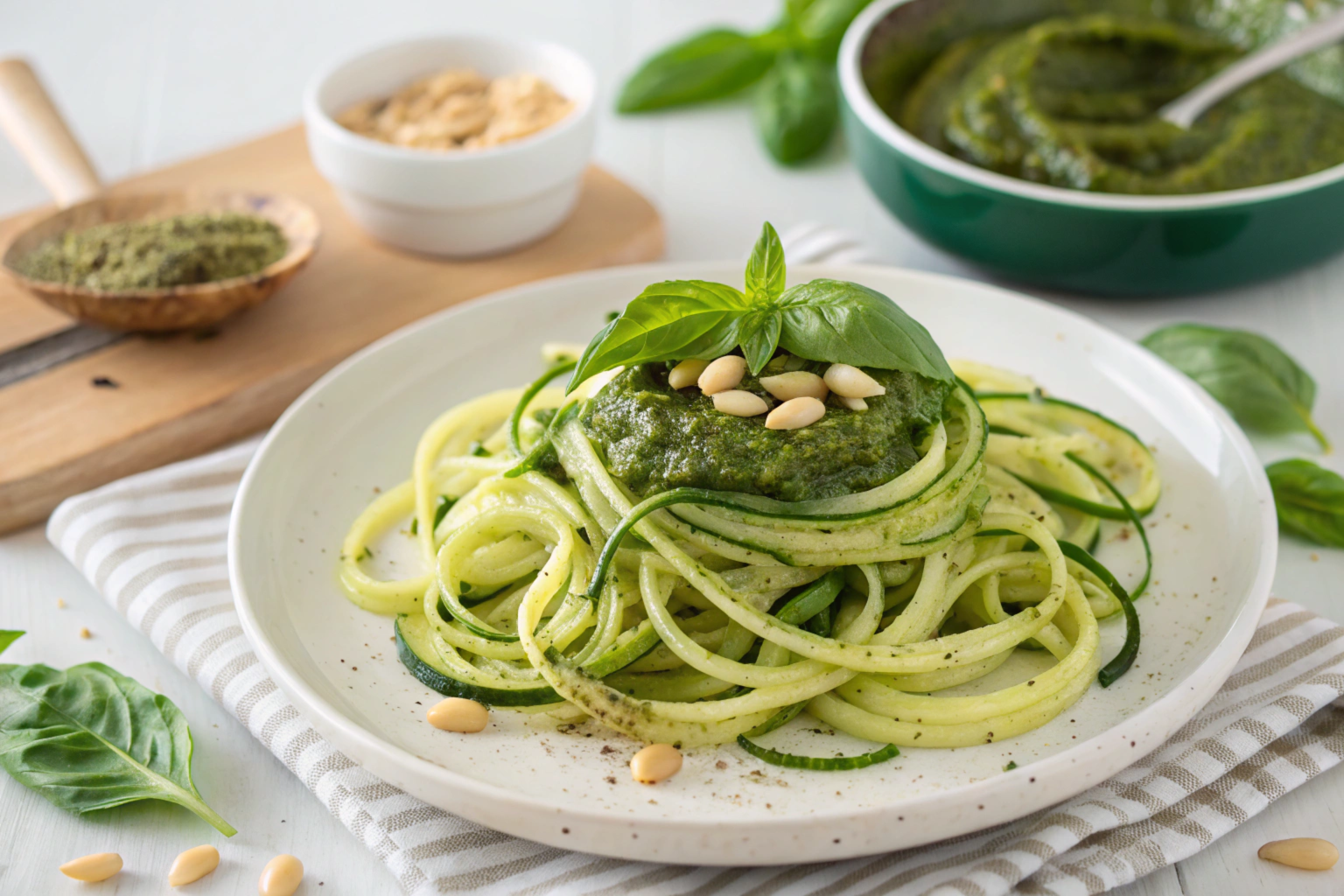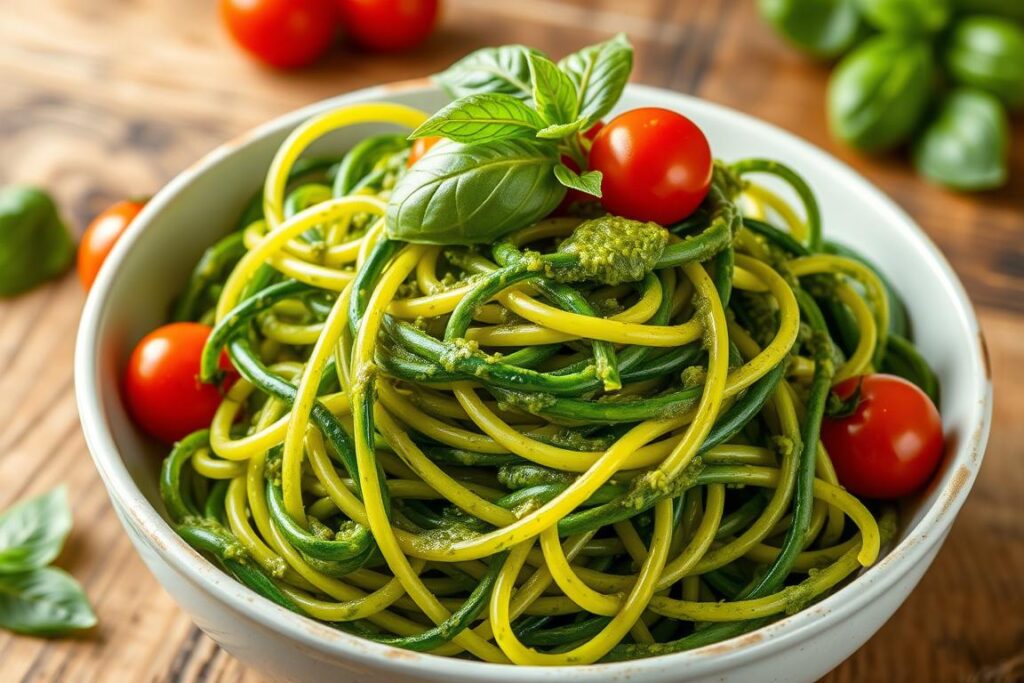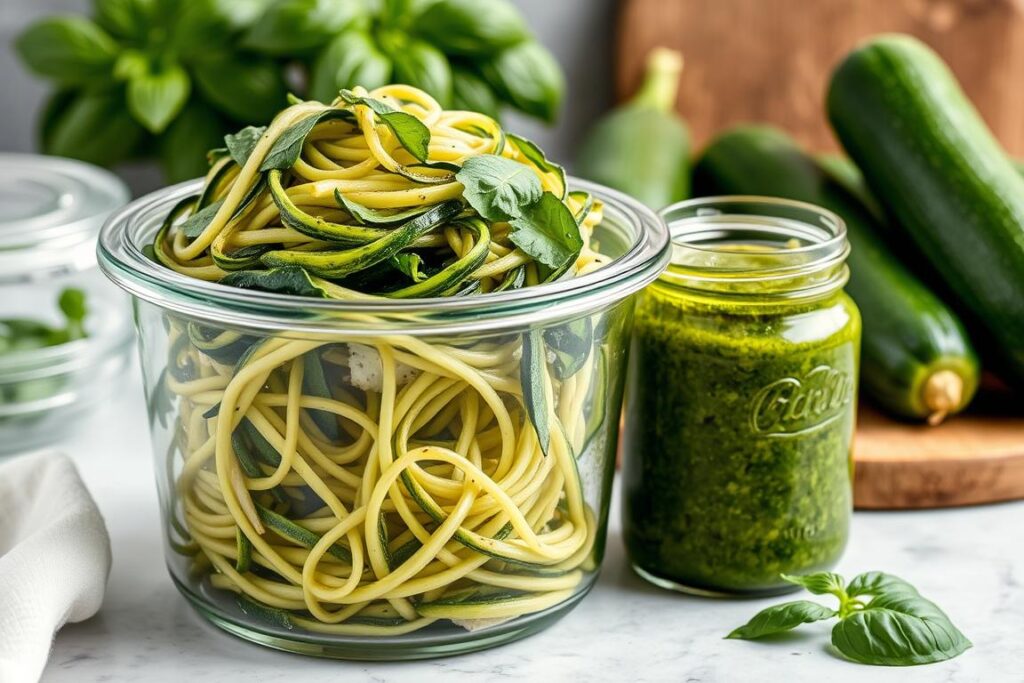I’m always searching for tasty and healthy meals. That’s how I found zucchini noodles with pesto. It’s a favorite at home and changed how I see pasta. Zucchini noodles are low in carbs, and homemade pesto makes the dish flavorful and satisfying.
This recipe is great for those watching their carb intake or wanting to eat more veggies. It’s also perfect for anyone looking to try new foods. Let’s explore this delicious and healthy dish together.
Key Takeaways
- Zucchini noodles are a low-carb, gluten-free alternative to traditional pasta
- Homemade pesto adds a burst of flavor and nutritional benefits to the dish
- This recipe is easy to prepare and can be customized to suit various dietary needs
- Zucchini noodles with pesto offer a satisfying and nutrient-dense meal option
- Experimenting with different pesto variations can add variety to the dish
What are Zucchini Noodles?
Zucchini noodles, also known as Spiralized Zucchini or Vegetable Noodles, are a healthy choice. They are made by spiralizing or shredding fresh zucchini. These “noodles” are full of nutrients and low in calories, making them great for adding more veggies to your diet.
Benefits of Zucchini Noodles
Zucchini noodles have many health benefits over Gluten-Free Pasta and other pasta. They are:
- Low in calories, with a single cup containing only about 20 calories
- High in fiber, which promotes digestive health and feelings of fullness
- Rich in vitamins and minerals, including vitamin C, vitamin A, and potassium
- Gluten-free, making them a suitable choice for those with gluten sensitivities or Celiac disease
How to Make Zucchini Noodles
Making Spiralized Zucchini is easy with a few tools:
- Spiralizer: A dedicated kitchen gadget that transforms zucchini into long, thin noodles with a spiral shape.
- Julienne Peeler: A handheld tool that slices zucchini into thin, noodle-like strips.
- Mandoline Slicer: This kitchen slicer can be used to create flat, ribbon-like Vegetable Noodles from zucchini.
Using any of these methods, you get Spiralized Zucchini for your recipes. It’s a low-carb, nutrient-dense substitute for traditional pasta.
Understanding Pesto
Pesto is a vibrant, flavorful sauce from Genoa, Italy. It’s made with fresh basil, pine nuts, garlic, Parmesan cheese, and olive oil. This sauce is loved worldwide and pairs well with Pesto Sauce and other pasta.
Ingredients in Pesto
The key ingredients in Basil Pesto are:
- Fresh basil leaves
- Pine nuts or walnuts
- Garlic cloves
- Parmesan or Pecorino cheese
- Extra-virgin olive oil
- Salt and pepper to taste
Types of Pesto Sauces
While Basil Pesto is a favorite, there are many other pesto types. Some include:
- Vegan Pesto: This version uses nutritional yeast instead of Parmesan cheese.
- Kale Pesto: It uses kale for a vibrant, earthy taste.
- Sun-Dried Tomato Pesto: It’s rich and umami with sun-dried tomatoes, pine nuts, and garlic.
- Arugula Pesto: It has a peppery flavor from arugula.
These Pesto Sauce variations offer different flavors for your zucchini noodles.
How to Prepare Zucchini for Noodles
Getting the perfect Spiralized Zucchini or Zucchini Pasta is key to tasty and healthy Vegetable Noodles. You can use a spiralizer or other methods. The most important thing is to start with fresh, top-quality zucchini.
Spiralizing Techniques
Spiralizing zucchini is a great way to make long, thin Zucchini Noodles. Here’s how to do it:
- Wash and trim the ends of the zucchini.
- Put the zucchini in the spiralizer as the manual says.
- Turn the handle to make long, thin Spiralized Zucchini.
- Change the blade or setting for the noodle thickness you want.
Alternative Methods for Zucchini Noodles
If you don’t have a spiralizer, there are other ways to make zucchini noodles:
- Julienne Peeler: Make long, thin strips of zucchini with a julienne peeler.
- Vegetable Peeler: Peel the zucchini lengthwise for flat, ribbon-like Vegetable Noodles.
- Box Grater: Grate the zucchini with the big holes on a box grater for short noodles.
- Knife: Slice the zucchini lengthwise into thin strips with a sharp knife.
Choose the method that works best for you. Adjust the thickness and length of the Zucchini Noodles for your dish.
Cooking Methods for Zucchini Noodles
Zucchini noodles, or Zucchini Pasta, are a hit as a Low-Carb Pasta and Healthy Pasta Alternative. Choosing the right cooking method is key to getting the best texture and taste. Let’s look at sautéing and blanching, the two main ways to cook these veggie noodles.
Sautéing Zucchini Noodles
Sautéing is a fast and simple way to cook Zucchini Pasta. It keeps the noodles firm and adds a caramelized taste. Just heat some oil in a pan over medium-high, then add the noodles. Cook for 2-3 minutes, stirring often, until they’re just right.
Blanching Zucchini Noodles
Blanching makes the noodles tender and delicate. Boil salted water, then add the Zucchini Noodles for 30 seconds to 1 minute. Drain them quickly and cool them in an ice bath. This method keeps the noodles soft and colorful.
Remember, don’t overcook the Zucchini Pasta. It should be tender but still have some crunch. This way, it will hold up well with your favorite sauce or pesto.
Making Homemade Pesto
Make your meals more exciting with homemade Pesto Sauce. Whether you love traditional Basil Pesto or want to try Vegan Pesto, making it yourself is fun and rewarding.
Fresh Basil Pesto Recipe
To make classic Basil Pesto, you need a few ingredients:
- 2 cups fresh basil leaves
- 1/2 cup pine nuts or walnuts
- 3 cloves garlic, minced
- 1/2 cup grated Parmesan cheese
- 1/2 cup extra-virgin olive oil
- 1/4 teaspoon salt
- 1/4 teaspoon black pepper
In a food processor or blender, mix the basil, nuts, garlic, and Parmesan. Pulse until it’s finely chopped. Then, slowly add the olive oil while blending. Keep going until it’s smooth and creamy. Add salt and pepper to taste. Your homemade Basil Pesto is now ready to make your Zucchini Noodles or other dishes even better!
Nut-Free Pesto Variations
If you can’t have nuts, don’t worry. There are tasty Nut-Free Pesto options. You can use sunflower seeds or pumpkin seeds instead. Or, try adding spinach or arugula for a new twist on Pesto Sauce.
“Pesto is the perfect complement to the light, refreshing flavors of Zucchini Noodles. Homemade pesto allows you to control the ingredients and customize the flavors to your liking.”
Combining Zucchini Noodles and Pesto
Zucchini Noodles with Pesto is a tasty low-carb pasta option. It lets you enjoy pasta flavors without the carbs. The secret to a great mix is knowing how to blend the noodles and pesto.
Mixing Techniques for Optimal Flavor
To get the best flavor mix, toss the zucchini noodles with pesto gently. This way, the noodles get coated evenly without getting soggy. You can also sauté the noodles lightly before adding pesto to make them taste better.
Serving Suggestions
Serving Zucchini Noodles with Pesto is fun and easy. Try it on its own with Parmesan cheese and basil. Or, add grilled chicken, shrimp, or tofu for extra protein.
For a pretty dish, twirl the Low-Carb Pasta into a nest. Top it with pesto, cherry tomatoes, and nuts or walnuts.
Try different pesto flavors like sun-dried tomato or arugula. This adds a special touch to your Zucchini Noodles with Pesto. The most important thing is to have fun and be creative.
Nutritional Benefits of Zucchini Noodles with Pesto
Zucchini noodles with pesto are a healthy pasta alternative. They are low-carb and gluten-free. Plus, they offer more nutritional benefits than regular pasta.
Low-Calorie Advantage
Zucchini noodles have fewer calories than regular pasta. A serving of zucchini noodles has a lot fewer calories. This makes them a great choice for those watching their calorie intake.
Rich in Vitamins and Minerals
Zucchini is full of vitamins and minerals. When you add pesto, you get even more nutrients. Zucchini is rich in vitamin C, vitamin B6, and manganese. Pesto adds antioxidants and healthy fats from olive oil and pine nuts.
| Nutrient | Zucchini Noodles | Traditional Pasta |
|---|---|---|
| Calories | 20 calories per cup | 200 calories per cup |
| Carbohydrates | 4 grams per cup | 40 grams per cup |
| Fiber | 1 gram per cup | 2 grams per cup |
| Vitamin C | 35% of the RDI per cup | 0% of the RDI per cup |
| Vitamin B6 | 12% of the RDI per cup | 2% of the RDI per cup |
Choosing zucchini noodles with pesto is a smart choice. They are low in calories and carbs but high in vitamins and minerals. It’s a nutritious and tasty meal option.
Pairing Zucchini Noodles with Other Ingredients
Exploring Zucchini Noodles with Pesto opens up a world of tasty and healthy meals. You can mix and match ingredients to find the perfect match for vegetable noodles. This way, you can make your dishes more exciting and nutritious.
Protein Options to Add
To make your Zucchini Noodles with Pesto more filling, add some protein. Here are some great choices:
- Grilled or sautéed chicken or shrimp
- Pan-seared salmon or tuna
- Crumbled feta or grated Parmesan cheese
- Toasted pine nuts or sliced almonds
Flavor Enhancements and Fusions
Don’t just stick to the usual Zucchini Noodles with Pesto. Try new flavors and mix-ins to create unique dishes:
| Flavor Enhancement | Fusion Idea |
|---|---|
| Roasted garlic or sun-dried tomatoes | Zucchini Noodles with Pesto and Lemon-Garlic Shrimp |
| Sautéed mushrooms or caramelized onions | Zucchini Noodles with Pesto and Grilled Chicken |
| Fresh herbs like basil, parsley, or oregano | Zucchini Noodles with Pesto and Roasted Vegetables |
Play with different healthy pasta alternatives and flavors. This way, you can make a variety of tasty and healthy meals that you’ll love.
Storage Tips for Zucchini Noodles and Pesto
Keeping your homemade Zucchini Pasta and Pesto Sauce fresh is key for a great meal. Whether you’ve made zucchini noodles or pesto, right storage keeps them fresh. This way, you can enjoy them at their best.
Best Practices for Freshness
To keep your Spiralized Zucchini noodles fresh, store them in an airtight container. Don’t wash them before storing to avoid sogginess. Just rinse them before using with your pesto.
For pesto, put it in an airtight container and cover it with olive oil. This keeps the color and flavor bright. You can store it in the fridge for a week or freeze it for months.
How to Store Leftovers
- Store leftover zucchini noodles in an airtight container, away from the pesto. This keeps them crisp.
- If noodles and pesto are mixed, store them together in a sealed container. Enjoy within 3-4 days. Reheat gently.
- Frozen pesto thaws in the fridge overnight or at room temperature in a few hours. Stir well before using.
By following these tips, you can enjoy your Zucchini Pasta and Pesto Sauce for days. Enjoy your healthy, tasty meal anytime!
Creative Ways to Serve Zucchini Noodles with Pesto
Zucchini noodles with pesto are great for many meals. They’re perfect for quick dinners or meal prep. Try them to mix up your meals with tasty and healthy options.
Meal Prep Ideas
Make Zucchini Noodles with Pesto in bulk for busy days. Store them in portions for a quick lunch or dinner. Add grilled chicken, roasted veggies, or nuts for a full meal.
Recipe Variations for Different Diets
Make Zucchini Noodles with Pesto fit any diet. For a low-carb pasta, use a dairy-free pesto. Or, pick a nut-free pesto for a gluten-free pasta option. This way, everyone can enjoy a delicious, healthy meal.
FAQ
What are zucchini noodles?
Zucchini noodles, or “zoodles,” are long, thin zucchini strips that look like pasta. They’re a healthy, low-carb choice instead of regular pasta.
What are the benefits of zucchini noodles?
Zucchini noodles are low in carbs and gluten-free. They’re also full of vitamins and minerals. Adding them to your diet can help with health and weight goals.
How do I make zucchini noodles?
You can make zucchini noodles with a spiralizer, julienne peeler, or sharp knife. A spiralizer is the most common tool for making long, thin strips.
What is pesto, and what are the different types?
Pesto is a tasty sauce made from basil, olive oil, pine nuts, Parmesan cheese, and garlic. There’s traditional green pesto, red pesto with sun-dried tomatoes, vegan pesto, and nut-free pesto.
How do I prepare zucchini for noodles?
First, wash and trim the zucchini. Then, use a spiralizer, julienne peeler, or sharp knife to make the strips. Some people lightly salt the noodles to remove moisture before cooking.
How do I cook zucchini noodles?
You can cook zucchini noodles by sautéing or blanching. Sautéing in oil or broth softens them and adds flavor. Blanching briefly boils them and then cools them in ice water to keep their texture and color.
How do I make homemade pesto?
Making pesto at home is simple and lets you customize flavors. Blend basil, olive oil, pine nuts, Parmesan cheese, and garlic. Try variations like nut-free or vegan pesto.
How do I combine zucchini noodles and pesto?
Toss cooked zucchini noodles with pesto. Use a gentle mix to coat the noodles without breaking them. Serve warm or at room temperature for the best taste and texture.
What are the nutritional benefits of zucchini noodles with pesto?
Zucchini noodles with pesto are a nutritious, low-calorie pasta alternative. Zucchini is full of vitamins, minerals, and fiber. Pesto adds healthy fats and antioxidants, making it a filling and healthy meal.
What other ingredients can I pair with zucchini noodles and pesto?
You can add many ingredients to zucchini noodles and pesto. Try grilled or sautéed chicken or shrimp, roasted veggies, cherry tomatoes, toasted nuts, and Parmesan cheese.
How do I store zucchini noodles and pesto?
Store zucchini noodles in an airtight container in the fridge for up to 5 days. Keep pesto in a sealed container with olive oil on top to prevent browning. Refrigerate for up to 1 week. Freeze pesto in ice cube trays for longer storage.
What are some creative ways to serve zucchini noodles with pesto?
Serve zucchini noodles with pesto in many ways. Try them in meal prep bowls, with roasted veggies, or as a base for a protein-packed salad. Experiment with different pesto flavors for variety.



